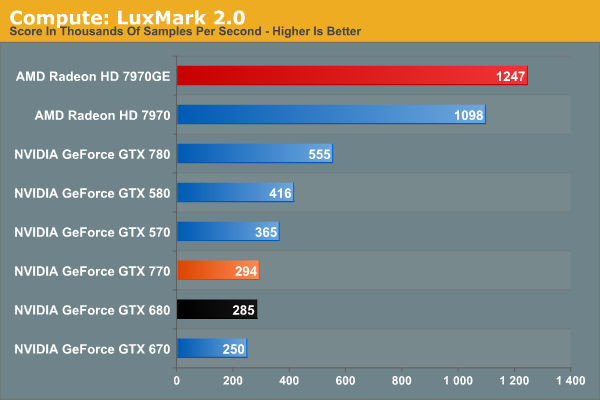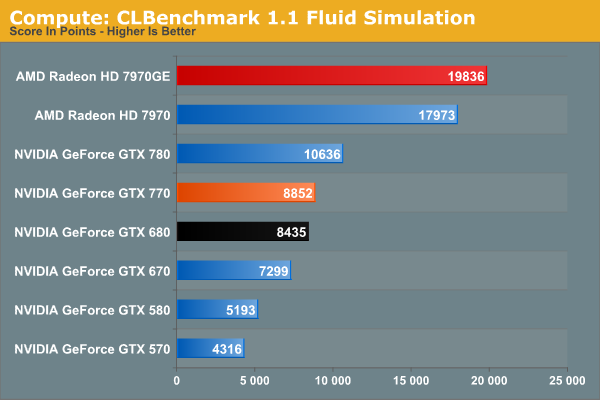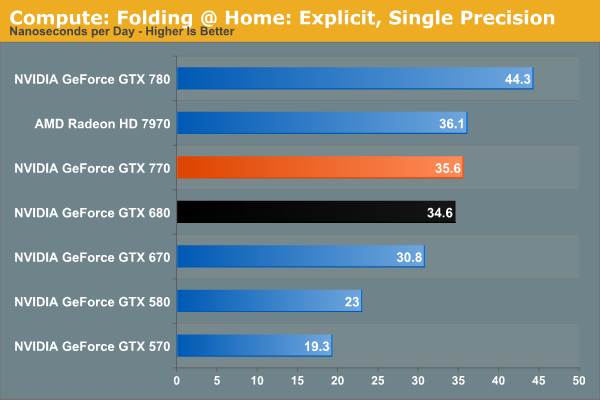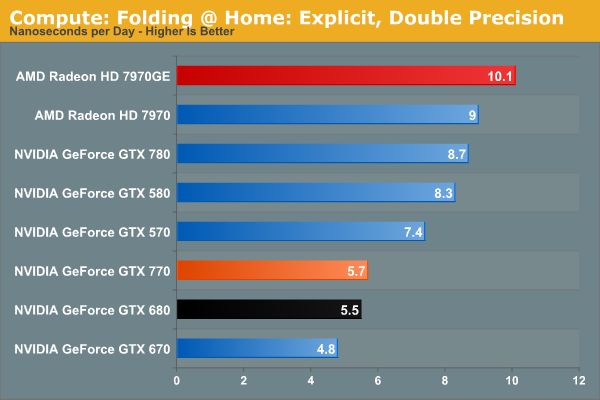NVIDIA GeForce GTX 770 Review: The $400 Fight
by Ryan Smith on May 30, 2013 9:00 AM ESTCompute
Jumping into compute, we aren’t expecting too much here. Outside of DirectCompute GK104 is generally a poor compute GPU, and other than the clockspeed boost GTX 770 doesn’t have much going for it.
As always we'll start with our DirectCompute game example, Civilization V, which uses DirectCompute to decompress textures on the fly. Civ V includes a sub-benchmark that exclusively tests the speed of their texture decompression algorithm by repeatedly decompressing the textures required for one of the game’s leader scenes. While DirectCompute is used in many games, this is one of the only games with a benchmark that can isolate the use of DirectCompute and its resulting performance.

Civilization V at least shows that NVIDIA’s DirectCompute performance is up to snuff in this case. Though as is the case with GTX 780, we’re reaching the limits of what this benchmark can do, due to just how fast modern cards have become.
Our next benchmark is LuxMark2.0, the official benchmark of SmallLuxGPU 2.0. SmallLuxGPU is an OpenCL accelerated ray tracer that is part of the larger LuxRender suite. Ray tracing has become a stronghold for GPUs in recent years as ray tracing maps well to GPU pipelines, allowing artists to render scenes much more quickly than with CPUs alone.

Moving on to a more general compute task, we get a reminder of how poor GK104 is here. GTX 770 can beat the slower GK104 products, and that’s it. Even GTX 570 is faster, never mind the massive lead that 7970GE holds.
Our 3rd benchmark set comes from CLBenchmark 1.1. CLBenchmark contains a number of subtests; we’re focusing on the most practical of them, the computer vision test and the fluid simulation test. The former being a useful proxy for computer imaging tasks where systems are required to parse images and identify features (e.g. humans), while fluid simulations are common in professional graphics work and games alike.


CLBenchmark paints GTX 770 in a better light than LuxMark, but not by a great deal. The gains over the GTX 680 are miniscule since these benchmarks aren’t memory bandwidth limited, and the gap between it and the 7970GE is nothing short of enormous.
Moving on, our 4th compute benchmark is FAHBench, the official Folding @ Home benchmark. Folding @ Home is the popular Stanford-backed research and distributed computing initiative that has work distributed to millions of volunteer computers over the internet, each of which is responsible for a tiny slice of a protein folding simulation. FAHBench can test both single precision and double precision floating point performance, with single precision being the most useful metric for most consumer cards due to their low double precision performance. Each precision has two modes, explicit and implicit, the difference being whether water atoms are included in the simulation, which adds quite a bit of work and overhead. This is another OpenCL test, as Folding @ Home has moved exclusively to OpenCL this year with FAHCore 17.


Recent core improvements in Folding @ Home continue to pay off for NVIDIA. In single precision the GTX 770 is just fast enough to hang with the 7970 vanilla, though the 7970GE is still over 10% faster. Double precision on the other hand is entirely in AMD’s favor thanks to GK104’s very poor FP64 performance.
Wrapping things up, our final compute benchmark is an in-house project developed by our very own Dr. Ian Cutress. SystemCompute is our first C++ AMP benchmark, utilizing Microsoft’s simple C++ extensions to allow the easy use of GPU computing in C++ programs. SystemCompute in turn is a collection of benchmarks for several different fundamental compute algorithms, as described in this previous article, with the final score represented in points. DirectCompute is the compute backend for C++ AMP on Windows, so this forms our other DirectCompute test.

Unlike our other compute benchmarks, System Compute is at least a little bit memory bandwidth sensitive, so GTX 770 pulls ahead of GTX 680 by 11%. Otherwise like every other compute benchmark, AMD’s cards fare far better here.










117 Comments
View All Comments
LoccOtHaN - Friday, May 31, 2013 - link
True Bro ;-) AMD is more user friendly, but when Next-Gen on ATI/AMD comes PS4 and M$ XBx1 then all optimalisation will be AMD friendly and DX11.1 (DX11.x or Full DX11) and we won !whyso - Thursday, May 30, 2013 - link
Well looks like the 7970 ghz has been tied. Lower price is nice but almost no OC headroom (wouldn't be surprised if AT got a cherry picked sample) and no game bundle. Similar power consumption too. Performance increase is virtually 0 but the price decrease is nice.A5 - Thursday, May 30, 2013 - link
Worth pointing out that you can pretty easily get the AMD bundle codes for ~$30 on eBay. It wipes out the price advantage, but it does let you weigh the cards on the merits of their hardware.steve_rogers42 - Thursday, May 30, 2013 - link
Think there is an error on page 7,"Of course this is only a 9% increase in the GPU clockspeed, which is going to pale in comparison to parts like GTX 670 and GTX 780, each of which can do 20%+ due to their lower clockspeeds. So there’s some overclocking headroom in GTX 780, but as to be expected not a ton."
Last sentence should read GTX 770 yea?
Great article, good to see nvidia's progress with the GPU boost 2 and taking on-board the tdp/power issue that the 600 series seems to have had. It will be interesting to see what they make of the 760 and what it will contain.
Cheers,
nathanddrews - Thursday, May 30, 2013 - link
Wow... at worst it is equal with the 680 for $100 less. At best, it is tied with the 780 for $250 less. I think NVIDIA needs to reexamine their pricing model - I'm sure the market will fix it for them. Either the 770 is too cheap or the 780 is way too expensive. (signs point to the latter)shompa - Thursday, May 30, 2013 - link
GTX 780 die is huge. It costs Nvidia almost double to manufacture a 780GTX then a 770/680 die.Only if Nvidia have enough harvested defect dies from Tesla chips they could/would lower the price on GTX 780.
EJS1980 - Thursday, May 30, 2013 - link
If the 780 performs better than the 680 by 30-35% out the gate w/ crappy day1 drivers (future updates will only increase that advantage), how exactly is it tied with the 770?nathanddrews - Thursday, May 30, 2013 - link
How exactly is it tied? Like I said, at its best.http://www.anandtech.com/bench/Product/829?vs=827
770 and 780 tied (within +/-5%):
DiRT: Showdown - 1920x1080 - Ultra Quality + 4xMSAA
Sleeping Dogs - 1920x1080 - Ultra Quality + Normal AA
Battlefield 3 - 1920x1080 - Ultra Quality + FXAA-High
Compute: Civilization V
Compute: Sony Vegas Pro 12 Video Render
Synthetic: 3DMark Vantage Pixel Fill
EJS1980 - Thursday, May 30, 2013 - link
Your link shows the 780 with a pretty substantial performance advantage, save for a couple instances. I stand by my comment.nathanddrews - Saturday, June 1, 2013 - link
It's easy to stand by your comment if you completely ignore what I wrote and ignore the facts. For instance, the 680 was not tested with "crappy day1 drivers", it was tested with very recent 320.14 drivers while the 770/780 used 320.18. In addition, I never said that the 770 was always tied with the 780, I said "at its best", which means that at the high end it ties the 780 in some benchmarks. At its worst, on the low end, the 770 is tied with the 680 in some benchmarks. I hope that clarifies things for you.